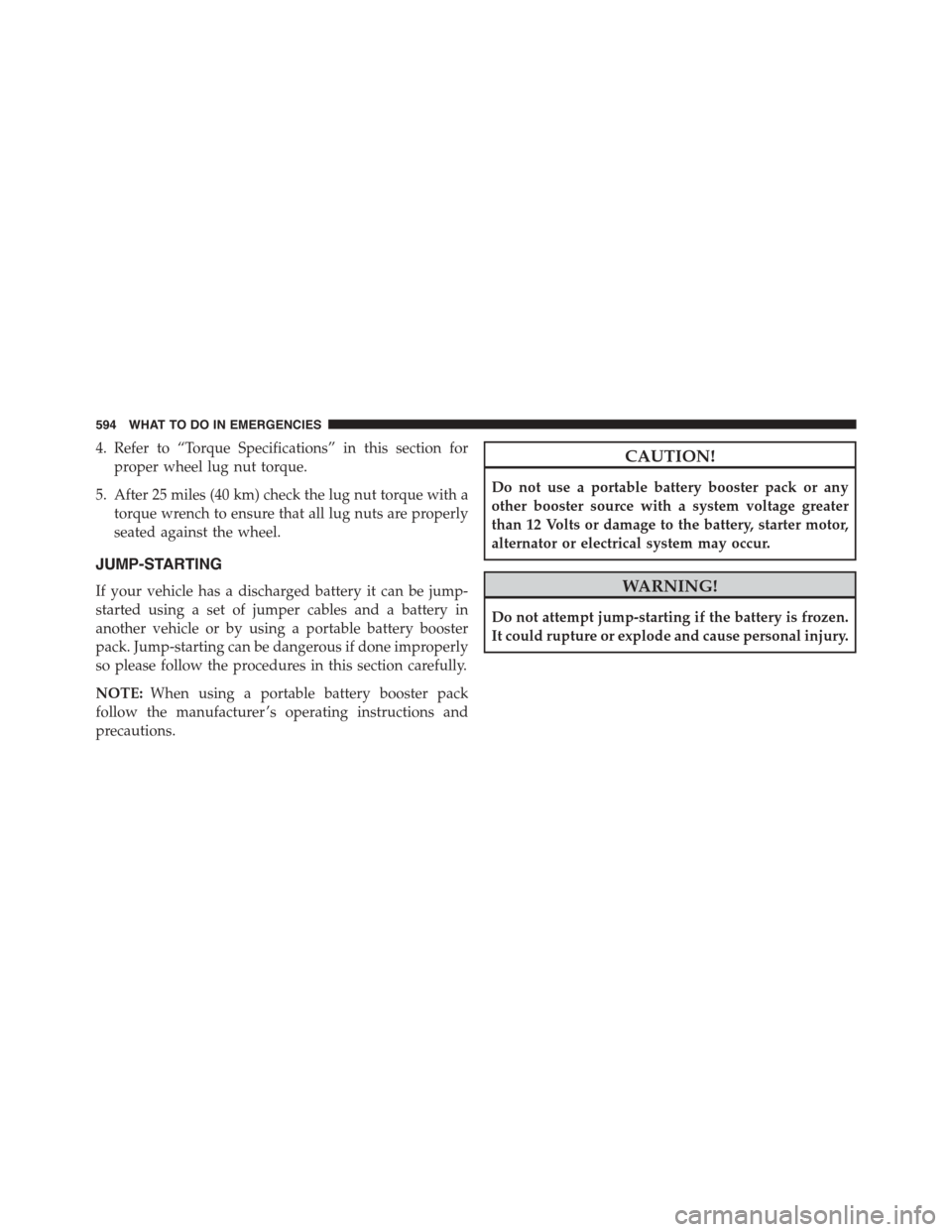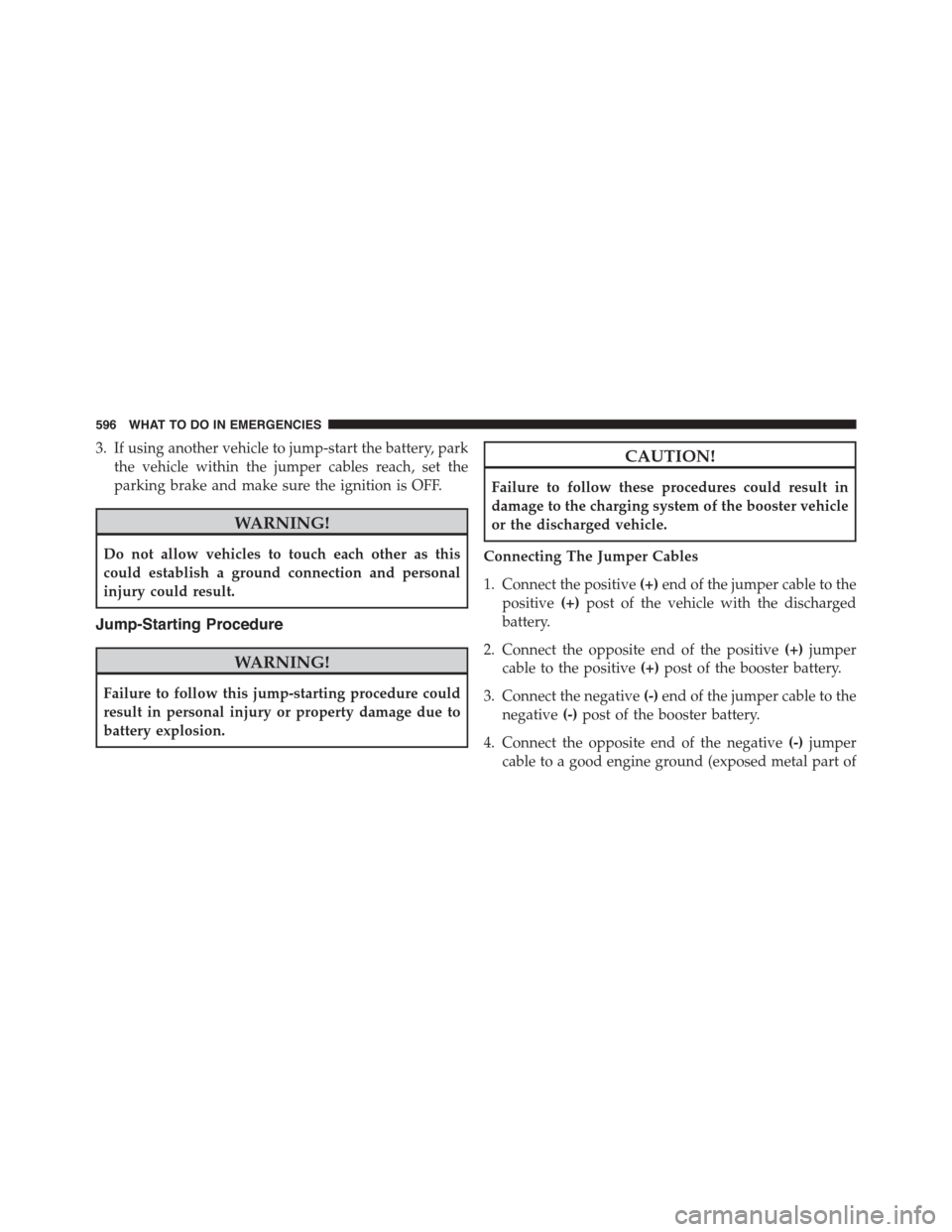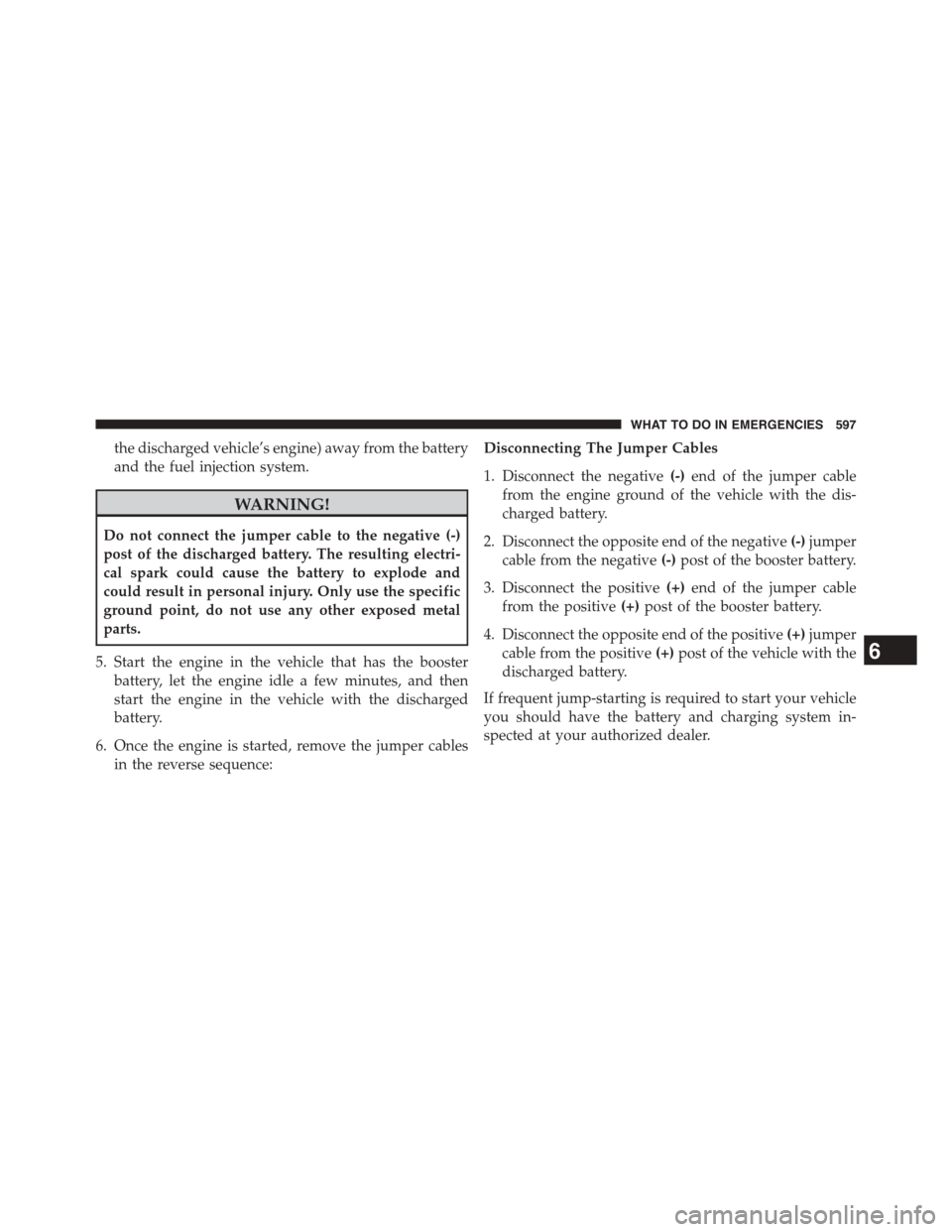2015 DODGE GRAND CARAVAN jump start
[x] Cancel search: jump startPage 596 of 703

4. Refer to “Torque Specifications” in this section for
proper wheel lug nut torque.
5. After 25 miles (40 km) check the lug nut torque with a
torque wrench to ensure that all lug nuts are properly
seated against the wheel.
JUMP-STARTING
If your vehicle has a discharged battery it can be jump-
started using a set of jumper cables and a battery in
another vehicle or by using a portable battery booster
pack. Jump-starting can be dangerous if done improperly
so please follow the procedures in this section carefully.
NOTE:When using a portable battery booster pack
follow the manufacturer ’s operating instructions and
precautions.
CAUTION!
Do not use a portable battery booster pack or any
other booster source with a system voltage greater
than 12 Volts or damage to the battery, starter motor,
alternator or electrical system may occur.
WARNING!
Do not attempt jump-starting if the battery is frozen.
It could rupture or explode and cause personal injury.
594 WHAT TO DO IN EMERGENCIES
Page 597 of 703

Preparations For Jump-Start
The battery in your vehicle is located on the left side of
the engine compartment.
WARNING!
•Take care to avoid the radiator cooling fan when-
ever the hood is raised. It can start anytime the
ignition switch is ON. You can be injured by
moving fan blades.
•Remove any metal jewelry such as rings, watch
bands and bracelets that could make an inadvertent
electrical contact. You could be seriously injured.
•Batteries contain sulfuric acid that can burn your
skin or eyes and generate hydrogen gas which is
flammable and explosive. Keep open flames or
sparks away from the battery.
1. Set the parking brake, shift the automatic transmission
into PARK and turn the ignition to LOCK.
2. Turn off the heater, radio, and all unnecessary electri-
cal accessories.
Positive Battery Post
6
WHAT TO DO IN EMERGENCIES 595
Page 598 of 703

3. If using another vehicle to jump-start the battery, park
the vehicle within the jumper cables reach, set the
parking brake and make sure the ignition is OFF.
WARNING!
Do not allow vehicles to touch each other as this
could establish a ground connection and personal
injury could result.
Jump-Starting Procedure
WARNING!
Failure to follow this jump-starting procedure could
result in personal injury or property damage due to
battery explosion.
CAUTION!
Failure to follow these procedures could result in
damage to the charging system of the booster vehicle
or the discharged vehicle.
Connecting The Jumper Cables
1. Connect the positive(+)end of the jumper cable to the
positive(+)post of the vehicle with the discharged
battery.
2. Connect the opposite end of the positive(+)jumper
cable to the positive(+)post of the booster battery.
3. Connect the negative(-)end of the jumper cable to the
negative(-)post of the booster battery.
4. Connect the opposite end of the negative(-)jumper
cable to a good engine ground (exposed metal part of
596 WHAT TO DO IN EMERGENCIES
Page 599 of 703

the discharged vehicle’s engine) away from the battery
and the fuel injection system.
WARNING!
Do not connect the jumper cable to the negative (-)
post of the discharged battery. The resulting electri-
cal spark could cause the battery to explode and
could result in personal injury. Only use the specific
ground point, do not use any other exposed metal
parts.
5. Start the engine in the vehicle that has the booster
battery, let the engine idle a few minutes, and then
start the engine in the vehicle with the discharged
battery.
6. Once the engine is started, remove the jumper cables
in the reverse sequence:
Disconnecting The Jumper Cables
1. Disconnect the negative(-)end of the jumper cable
from the engine ground of the vehicle with the dis-
charged battery.
2. Disconnect the opposite end of the negative(-)jumper
cable from the negative(-)post of the booster battery.
3. Disconnect the positive(+)end of the jumper cable
from the positive(+)post of the booster battery.
4. Disconnect the opposite end of the positive(+)jumper
cable from the positive(+)post of the vehicle with the
discharged battery.
If frequent jump-starting is required to start your vehicle
you should have the battery and charging system in-
spected at your authorized dealer.
6
WHAT TO DO IN EMERGENCIES 597
Page 621 of 703

WARNING!
•Battery fluid is a corrosive acid solution and can
burn or even blind you. Do not allow battery fluid
to contact your eyes, skin, or clothing. Do not lean
over a battery when attaching clamps. If acid
splashes in eyes or on skin, flush the area imme-
diately with large amounts of water. Refer to
“Jump-Starting Procedures” in “What To Do In
Emergencies” for further information.
•Battery gas is flammable and explosive. Keep
flame or sparks away from the battery. Do not use
a booster battery or any other booster source with
an output greater than 12 Volts. Do not allow cable
clamps to touch each other.
•Battery posts, terminals, and related accessories
contain lead and lead compounds. Wash hands
after handling.
CAUTION!
•It is essential when replacing the cables on the
battery that the positive cable is attached to the
positive post and the negative cable is attached to
the negative post. Battery posts are marked positive
(+) and negative (-) and are identified on the
battery case. Cable clamps should be tight on the
terminal posts and free of corrosion.
•If a “fast charger” is used while the battery is in the
vehicle, disconnect both vehicle battery cables be-
fore connecting the charger to the battery. Do not
use a “fast charger” to provide starting voltage.
Air Conditioner Maintenance
For best possible performance, your air conditioner should
be checked and serviced by an authorized dealer at the
start of each warm season. This service should include
cleaning of the condenser fins and a performance test.
Drive belt tension should also be checked at this time.
7
MAINTAINING YOUR VEHICLE 619
Page 683 of 703

Anti-Lock Warning Light....................314
Appearance Care.........................635
Ashtray................................278
Assistance Towing.........................162
Assist, Hill Start..........................492
Auto Down Power Windows..................41
Automatic Dimming Mirror..................134
Automatic Door Locks......................38
Automatic Headlights......................223
Automatic Temperature Control (ATC)..........440
Automatic Transmission....................462
Adding Fluid..........................634
Fluid and Filter Changes..................634
Fluid Change..........................634
Fluid Level Check.......................634
Fluid Type............................633
Gear Ranges...........................467
Special Additives.......................633
Torque Converter.......................474
Auto Up Power Windows....................42
Battery.................................618
Jump Starting..........................594
Keyless Transmitter Replacement (RKE)........28
Saving Feature (Protection)................229
Belts, Seat...............................122
Body Mechanism Lubrication.................622
B-Pillar Location..........................502
Brake Assist System.......................487
Brake Control System, Electronic..............483
Brake Fluid.............................659
Brake System............................482
Anti-Lock (ABS)........................482
Fluid Check...........................631
Parking..............................480
Warning Light.........................320
Brake/Transmission Interlock.................464
BulbReplacement.........................65210
INDEX 681
Page 687 of 703

Jump Starting..........................594
Overheating...........................561
Emission Control System Maintenance..........609
Engine
Air Cleaner...........................615
Block Heater..........................462
Break-In Recommendations................120
Checking Oil Level......................612
Compartment..........................607
Compartment Identification................607
Coolant (Antifreeze).....................624
Cooling..............................624
Exhaust Gas Caution.....................121
Flooded, Starting.......................460
Fuel Requirements......................531
Oil . . . . . . . . . . . . . . . . . . . . . . . . . . . . . . . . ..612
Oil Selection...........................613
Oil Synthetic..........................615
Overheating...........................561
Starting..............................459
Temperature Gauge......................322
Engine Oil Viscosity.......................614
Engine Oil Viscosity Chart...................614
Enhanced Accident Response Feature............91
Entry System, Illuminated....................20
Ethanol................................532
Event Data Recorder........................95
Exhaust Gas Caution.......................121
Exhaust System...........................121
Exterior Lights...........................125
Fabric Care..............................638
Filler Location Fuel........................318
Filters
Air Cleaner...........................615
Air Conditioning.......................452
Engine Oil............................615
Engine Oil Disposal.....................61510
INDEX 685
Page 691 of 703

Jump Starting............................594
Key Fob
Programming Additional Key Fobs...........17
Programming Additional Transmitters.........17
Key-In Reminder..........................15
Keyless Entry System.......................21
Key, Replacement..........................16
Keys...................................12
Key, Sentry (Immobilizer)....................15
Lane Change Assist........................228
Lap/Shoulder Belts.........................59
Latches................................125
Hood................................220
Lead Free Gasoline........................531
Leaks, Fluid.............................125
Life of Tires.............................517
Liftgate.................................52
Light Bulbs..............................125
Lights.................................125
Airbag................................92
Alarm...............................319
Anti-Lock.............................314
Automatic Headlights....................223
Back-Up..............................654
Battery Saver..........................229
Brake Assist Warning....................490
Brake Warning.........................320
Bulb Replacement.......................650
Center Mounted Stop....................655
Daytime Running.......................224
Dimmer Switch, Headlight.................225
Electronic Stability Program (ESP) Indicator.....490
Engine Temperature Warning...............323
Exterior..............................125
Fog . . . . . . . . . . . . . . . . . . . . . . . . . . . . . . . ..225
Hazard Warning Flasher..................56110
INDEX 689